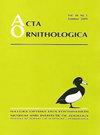Impact of Nest Predators on Migratory Woodpigeons Columba palumbus in Central Europe — Breeding Densities and Nesting Success in Urban Versus Natural Habitats
IF 1.3
4区 生物学
Q3 ORNITHOLOGY
引用次数: 3
Abstract
Abstract. The Woodpigeon Columba palumbus is a species generally increasing in numbers in most of its populations, including the urban population, which, two centuries after its emergence, is still expanding across the European Lowland. New for the species is a tendency to form dense breeding aggregations in suitable urban parks, with a corresponding slower increase in some other towns. This trend was driven by the presence of important nest predators, mostly Hooded Crows Corvus corone. Another factor involved was access to open farmland within the economic range of feeding flights. Nesting success (1st brood) in urban habitats free of important predators was up to 50–77% but it fell to only 3–7% when predators appeared. Consequently, some urban populations of the Woodpigeon went into a phase of decline. In the farmland and secondary woods, the nesting success was also variable, ranging between 12 and 42% for unknown reasons. Safe urban populations produced 4–5 times more offspring per pair per season, yet their expansion was rather slow. Therefore, the urban overproduction may contribute to an increase in the total species abundance, owing to (deduced) overspill of recruits to the poorly reproducing subpopulation in the countryside. Alongside other factors such as amelioration of winter conditions and changes in agriculture, this would contribute to the documented growth of the whole population of the species. The shortage of firm data on the pristine breeding success (from extensive natural forests) remains the main obstacle to better understand the population dynamics of this migratory species.巢穴捕食者对中欧迁徙木鸽Columba palumbus的影响——城市与自然栖息地的繁殖密度和筑巢成功率
摘要木鸽(Columba palumbus)是一种在其大多数种群中数量普遍增加的物种,包括城市种群,在其出现两个世纪后,仍在整个欧洲低地扩张。该物种的新趋势是在适宜的城市公园形成密集的繁殖聚集,而在其他一些城镇则相应增加较慢。这种趋势是由重要的巢穴捕食者的存在所驱动的,主要是冠鸦。另一个涉及的因素是在喂食飞机的经济范围内获得开放的农田。在无重要捕食者的城市生境中,第一窝产卵成功率可达50 ~ 77%,而在有捕食者的环境中,第一窝产卵成功率仅为3 ~ 7%。因此,一些城市的木鸽种群进入了下降阶段。在农田和次生林中,筑巢成功率也不稳定,介于12%到42%之间,原因不明。安全的城市种群每对后代的产生量是正常种群的4-5倍,但它们的扩张相当缓慢。因此,城市生产过剩可能会导致物种总丰度的增加,这是由于(推断的)农村繁殖不良亚群的新成员过多。加上其他因素,如冬季条件的改善和农业的变化,这将有助于该物种整体种群的增长。缺乏关于原始繁殖成功的可靠数据(来自广泛的天然森林)仍然是更好地了解这种迁徙物种的种群动态的主要障碍。
本文章由计算机程序翻译,如有差异,请以英文原文为准。
求助全文
约1分钟内获得全文
求助全文
来源期刊

Acta Ornithologica
生物-鸟类学
CiteScore
2.10
自引率
0.00%
发文量
14
审稿时长
>12 weeks
期刊介绍:
Publishes scientific papers (original research reports, reviews, short notes, etc.) and announcements from all fields of ornithology. All manuscripts are peer-reviewed.
Established in 1933 as Acta Ornithologica Musei Zoologici Polonici, since 1953 continued under the present title.
Published twice a year by the Natura Optima Dux Foundation under the auspices of the Museum and Institute of Zoology, Polish Academy of Sciences.
 求助内容:
求助内容: 应助结果提醒方式:
应助结果提醒方式:


